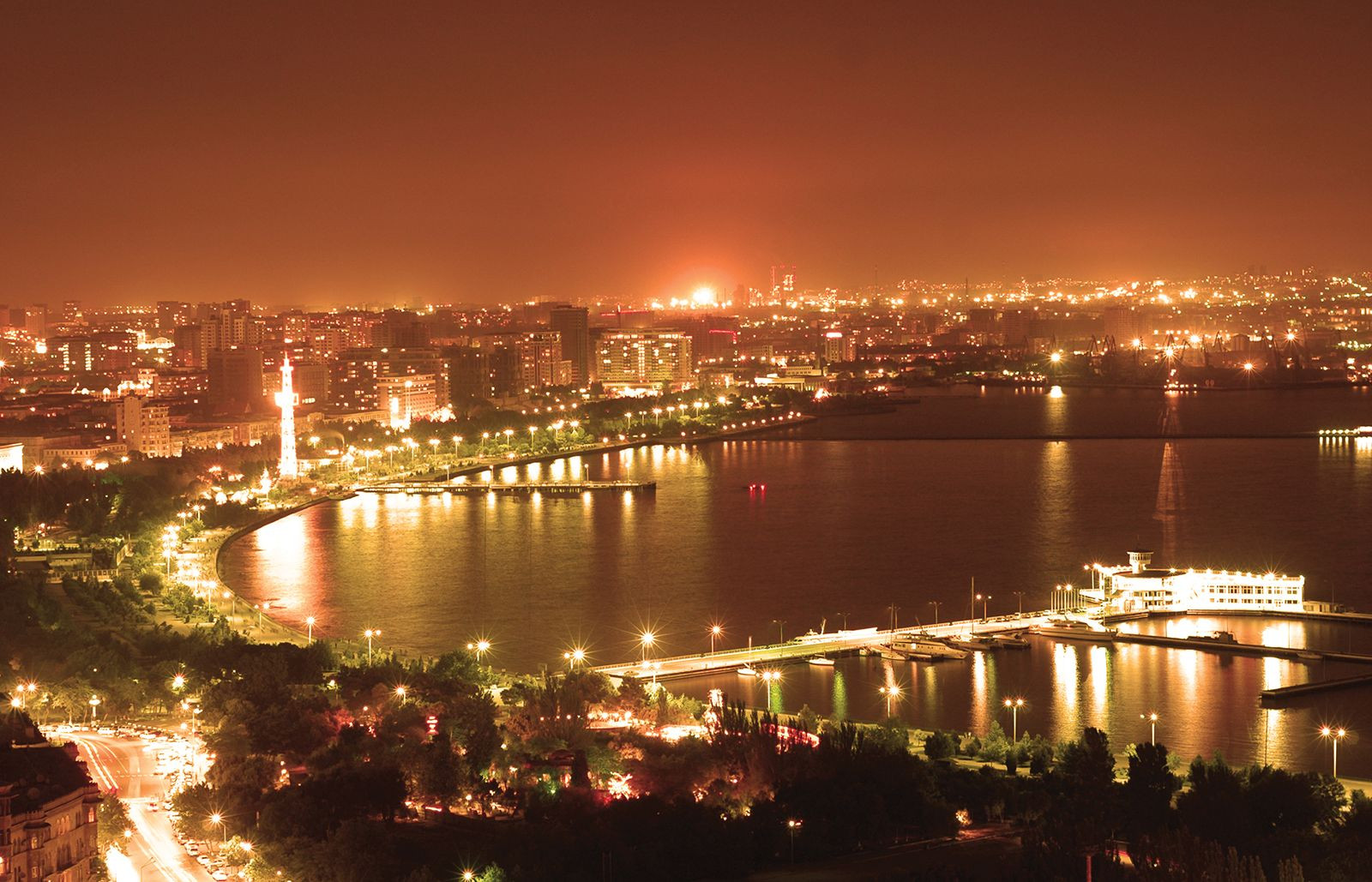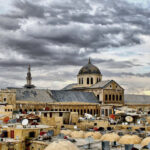Baku, a vibrant metropolis, serves as the capital city of Azerbaijan. This bustling urban center is strategically positioned on the western coast of the Caspian Sea, specifically on the southern edge of the Absheron Peninsula. Baku’s location curves gracefully around the Bay of Baku, a naturally sheltered harbor thanks to the Baku Archipelago islands. This unique geography not only provides Baku with the Caspian’s finest harbor but also shields it from harsh northerly winds, courtesy of the Absheron Peninsula. Some believe the name “Baku” itself is derived from the Persian phrase “bad kube,” meaning “blown upon by mountain winds,” aptly reflecting its windy coastal setting. Baku’s significance is deeply rooted in its rich oil reserves and its role as the administrative heart of Azerbaijan.
 Night view of Baku, Azerbaijan
Night view of Baku, Azerbaijan
A captivating night view of Baku, the capital of Azerbaijan, showcasing its modern skyline and illuminated cityscape.
Baku’s history stretches back centuries, with the earliest recorded mention dating to 885 CE. However, archaeological findings suggest a settlement existed here even earlier, possibly several centuries before Christ. By the 11th century, Baku came under the control of the Shirvanshahs, who elevated it to their capital in the 12th century. The city experienced periods under Mongol rule in the 13th and 14th centuries. In 1723, Peter the Great of Russia briefly captured Baku before it was returned to Persia in 1735. Russia eventually seized Baku permanently in 1806. A pivotal moment arrived in 1920 when Baku was declared the capital of the newly formed Azerbaijan Republic.
Contrasting view of Baku, Azerbaijan, blending the historic old city with modern skyscrapers in the background.
The heart of contemporary Baku is its ancient core, known as Icheri-Sheher, or the Old City. Much of the fortress walls, fortified after the Russian conquest in 1806, still stand today, alongside the iconic 90-foot Maiden’s Tower (Kyz-Kalasy), dating back to the 12th century. The Old City is a picturesque labyrinth of narrow winding alleys and time-honored structures. Among these are the Palace of the Shirvanshahs, now a museum with its oldest sections from the 11th century, and the Synyk-Kala Minaret and Mosque (built 1078–79). Other significant historical landmarks include the Divan-Khan (law court), the Juma-Mechet Minaret, and the mausoleum dedicated to astronomer Seida Bakuvi. Recognizing its historical and cultural importance, UNESCO designated the Walled City of Baku, including the Palace of the Shirvanshahs and Maiden’s Tower, as a World Heritage site in 2000.
A detailed locator map pinpointing the geographical location of Baku in Azerbaijan.
Surrounding the ancient fortress walls, modern Baku unfolds with its organized streets and grand buildings, ascending the hills that encircle the bay. A beautiful park graces the waterfront, offering scenic views. Industrial areas are primarily located in the eastern and southwestern parts of the city. Greater Baku encompasses 11 districts, extending across almost the entire Absheron Peninsula, including islands off the peninsula’s tip and even a city on stilts in the Caspian Sea, about 60 miles (100 km) from Baku.
 Oil derricks near Baku in the Caspian Sea
Oil derricks near Baku in the Caspian Sea
Oil derricks in the Caspian Sea near Baku, Azerbaijan, illustrating the region’s significant oil industry.
Petroleum is the cornerstone of Baku’s economy. Oil presence has been known since ancient times, with surface wells providing lamp oil as early as the 15th century. Modern commercial oil exploitation began in 1872. By the early 20th century, Baku’s oil field was the world’s largest and remained the biggest in the Soviet Union until the 1940s. As easily accessible reserves dwindled by the late 20th century, drilling operations expanded deeper underground and further into the Absheron Peninsula and Caspian seabed. After Azerbaijan’s independence, international companies were contracted to explore and develop new sites, leading to the establishment of new refineries. Many oil derricks are visible in the gulf facing the city. Subordinate towns often serve as drilling centers, connected by pipelines to refineries and processing plants. Oil from Baku is transported via pipeline to Batumi on the Black Sea or by tankers across the Caspian and up the Volga River. Beyond oil processing, Baku is a major hub for oil industry equipment manufacturing, alongside metalworking, shipbuilding, electrical machinery production, chemical and construction materials manufacturing, and food processing, all contributing to its diverse economy.
The modern architectural marvel of the Heydar Aliyev Centre in Baku, Azerbaijan, designed by Zaha Hadid.
Baku is also a significant cultural and educational center in Azerbaijan. It hosts Baku State University (established in 1919), Khazar University (1991), and Azerbaijan Technical University (1950), in addition to numerous other higher education institutions, including one specializing in the oil industry. The Azerbaijan Academy of Sciences supports numerous scientific research facilities. The city boasts museums like the State Art Museum (founded 1924) and others dedicated to education, history, and literature, as well as a vibrant theater scene. An international airport serves the city to the southeast. Azerbaijanis are the predominant ethnic group, with a notable Russian population as well. Baku is notably the birthplace of Lev Davidovich Landau, the 1962 Nobel Prize laureate in Physics. The estimated population of Baku in 2015 was 1,229,100.

